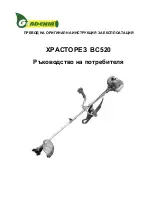
Remove the cylinder foot's four screws and lift up the cylinder.
New, run-in engine around 7.5 bar
Corrected under 5.5 bar
CYLINDER/PISTON
13
30
Cylinder
Dismantling
The service measures to be made determine the most appropriate method.
Dividing the machine at the anti-vibration elements provides the best visibility
and accessibility and is necessary for dividing the crankcase.
It can be beneficial to attach the engine body to a vice in order to facilitate
the process. Use soft protective jaws!
Remove the cutting head and cutting arm. Remove the carburettor and
muffler.
503 55 22-01
531 03 16-86
Compression test
– Warm up the engine for a few minutes.
– Remove the spark plug and connect the instrument.
– Make 5–6 attempts at starting with a closed decompression valve and read
the pressure gauge. Evacuate the pressure and repeat the procedure a few
times. Note the average value from the attempts.
The average value for a new and run-in engine is approximately 7.5 bar
(110 psi). Values below 5.5 bar (80 psi) indicate defects in the cylinder,
piston or piston rings.
Compression test
The test indicates leakage from
the combustion chamber.
Close the decompression
valve or fit the sealing plug
503 55 22-01.
Compression test
The compression test indicates leakage
from the combustion chamber. If the
machine lacks engine power and is diffi-
cult to start this may be due to poor
compression.
Close the decompression valve or fit
the sealing plug 503 55 22-01 to eliminate
the decompression valve as the source of
the fault.
Compression tester
The compression test is performed using
the measurement instrument 531 03 16-86,
which is connected to the spark plug
hole. The valve below the gauge evacuates
the pressure.
Compression tester
Connect the compression tester
in the spark plug hole.
















































